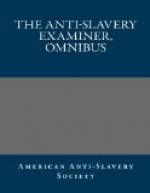[Footnote 16: To this, Rev. Mr. Scales adds, “In familiar language, and in more detail, as I have learned it in conversation with Mr. Chapin, the fact is as follows:—
“Mr. W. kept, what he called a ‘boy,’ i.e. a man, to go to mill. It was his custom not to give his slaves anything to eat while he was gone to mill—let him have been gone longer or shorter—for this reason, if he was lazy, and delayed, the slaves would become hungry: hence indignant, and abuse him—this was his punishment. On that occasion he went to mill in the morning. The slaves came up at noon, and returned to work without food. At night, after having worked hard all day, without food, went to bed without supper. About 10 o’clock the next day, they came up in a company, to their master’s door, (that master an elder in the church), and deputed one more resolute than the rest to address him. This he did in the most respectful tones and terms. “We are willing to work for you, master, but we can’t work without food; we want something to eat.” “Clear yourself,” was the answer. The slaves retired; and in the morning were driven away to work without food. At noon, I think, or somewhat after, they were fed.”]
“I know the slaves were sometimes severely whipped. I saw the backs of several which had numerous scars, evidently caused by long and deep lacerations of the whip; and I have good reason to believe that the slaves were generally in that condition; for I never saw the back of one exposed that was not thus marked,—and from their tattered and scanty clothing their backs were often exposed.”
TESTIMONY OF MESSRS. T.D.M. AND F.C. MACY.
This testimony is communicated in a letter from Mr. Cyrus Pierce, a respectable and well known citizen of Nantucket, Mass. Of the witnesses, Messrs. T.D.M. and F.C. Macy, Mr. Pierce says, “They are both inhabitants of this island, and have resided at the south; they are both worthy men, for whose integrity and intelligence I can vouch unqualifiedly; the former has furnished me with the following statement.
“During the winter of 1832-3, I resided on the island of St. Simon, Glynn county, Georgia. There are several extensive cotton plantations on the island. The overseer of the plantation on that part of the island where I resided was a Georgian—a man of stern character, and at times cruelly abusive to his slaves. I have often been witness of the abuse of his power. In South Carolina and




